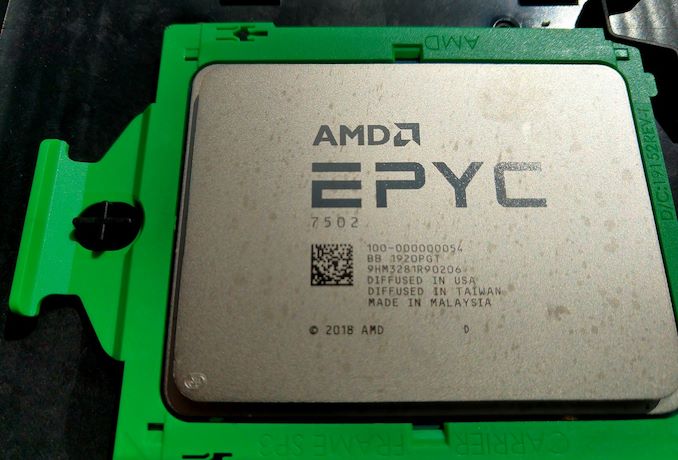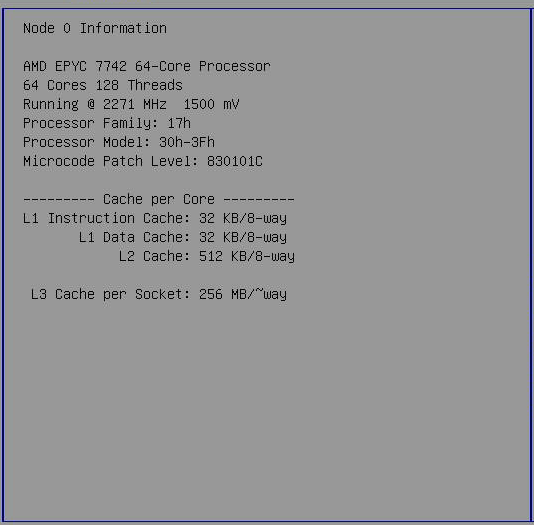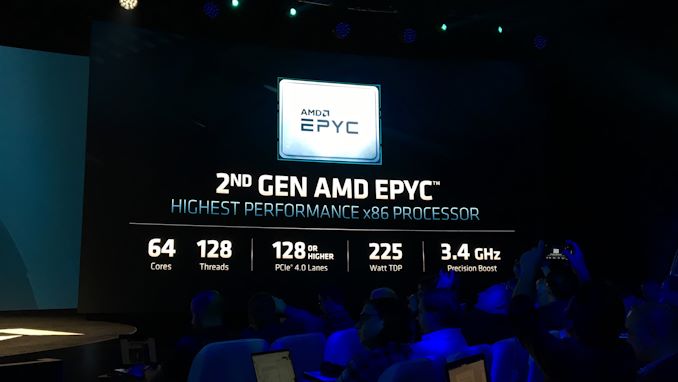AMD Rome Second Generation EPYC Review: 2x 64-core Benchmarked
by Johan De Gelas on August 7, 2019 7:00 PM EST
If you examine the CPU industry and ask where the big money is, you have to look at the server and datacenter market. Ever since the Opteron days, AMD's market share has been rounded to zero percent, and with its first generation of EPYC processors using its new Zen microarchitecture, that number skipped up a small handful of points, but everyone has been waiting with bated breath for the second swing at the ball. AMD's Rome platform solves the concerns that first gen Naples had, plus this CPU family is designed to do many things: a new CPU microarchitecture on 7nm, offer up to 64 cores, offer 128 lanes of PCIe 4.0, offer 8 memory channels, and offer a unified memory architecture based on chiplets. Today marks the launch of Rome, and we have some of our own data to share on its performance.
Review edited by Dr. Ian Cutress
First Boot
Sixty-four cores. Each core with an improved Zen 2 core, offering ~15% better IPC performance than Naples (as tested in our consumer CPU review), and doubled AVX2/FP performance. The chip has a total of 256 MB of L3 cache, and 128 PCIe 4.0 lanes. AMD's second generation EPYC, in this case the EPYC 7742, is a behemoth.
Boot to BIOS, check the node information.
[Note: That 1500 mV reading in the screenshot is the same reading we see on consumer Ryzen platforms; it seems to be the non-DVFS voltage as listed in the firmware, but isn't actually observed]
It is clear that the raw specifications of our new Rome CPU is some of the most impressive on the market. The question then goes to whether or not this is the the new fastest server chip on the market - a claim that AMD is putting all its weight behind. If this is the new fastest CPU on the market, the question then becomes 'by how much?', and 'how much does it cost?'.
I have been covering server CPUs since the launch of the Opteron in 2003, but this is nothing like I have seen before: a competitive core and twice as much of them on a chip than what the competition (Intel, Cavium, even IBM) can offer. To quote AMD's SVP of its Enterprise division, Forrest Norrod:
"We designed this part to compete with Ice Lake, expecting to make some headway on single threaded performance. We did not expect to be facing re-warmed Skylake instead. This is going to be one of the highlights of our careers"
Self-confidence is at all times high at AMD, and on paper it would appear to be warranted. The new Rome server CPUs have improved core IPC, a doubling of the core count at the high end, and it is using a new manufacturing process (7 nm) technology in one swoop. Typically we see a server company do one of those things at a time, not all three. It is indeed a big risk to take, and the potential to be exciting if everything falls into place.
To put this into perspective: promising up to 2x FP performance, 2x cores, and a new process technology would have sounded so odd a few years ago. At the tail end of the Opteron days, just 4-5 years ago, Intel's best CPUs were up to three times faster. At the time, there was little to no reason whatsoever to buy a server with AMD Opterons. Two years ago, EPYC got AMD back into the server market, but although the performance per dollar ratio was a lot better than Intel's, it was not a complete victory. Not only was AMD was still trailing in database performance and AVX/FP performance, but partners and OEMs were also reluctant to partner with the company without a proven product.
So now that AMD has proven its worth with Naples, and AMD promising more than double the deployed designs of Rome with a very quick ramp to customers, we have to compare the old to the new. For the launch of the new hardware, AMD provided us with a dual EPYC 7742 system from Quanta, featuring two 64-core CPUs.












180 Comments
View All Comments
Kevin G - Wednesday, August 7, 2019 - link
Clock speeds. AMD is being very aggressive on clocks here but the Ryzen 3000 series were still higher. I would expect new Threadripper chips to clock closer to their Ryzen 3000 cousins.AMD *might* differentiate Threadripper by cache amounts. While the CPU cores work, they may end up binning Threadripper based upon the amount of cache that wouldn't pass memory tests.
Last thing would be price. The low end Epyc chips are not that expensive but suffer from low cores/low clocks. Threadripper can offer more for those prices.
quorm - Wednesday, August 7, 2019 - link
Here's hoping we see a 16 core threadripper with a 4ghz base clock.azfacea - Wednesday, August 7, 2019 - link
half memory channels. half pcie lanes. also i think with epyc AMD spends more on support and system development. i can see 48c 64c threadripper coming 30-40% lower and not affecting epyctwtech - Wednesday, August 7, 2019 - link
If they gimp the memory access again, it mostly defeats the purpose of TR as a workstation chip. You'd want an Epyc anyway.quorm - Wednesday, August 7, 2019 - link
Well, on the plus side, the i/o die should solve the asymmetric memory access problem.ikjadoon - Wednesday, August 7, 2019 - link
Stunning.aryonoco - Wednesday, August 7, 2019 - link
Between 50% to 100% higher performance while costing between 40% to 50% less. Stunning!I remember the sad days of Opteron in 2012 and 2013. If you'd told me that by the end of the decade AMD would be in this position, I'd have wanted to know what you're on.
Everyone at AMD deserves a massive cheer, from the technical and engineering team all the way to Lisa Su, who is redefining what "execution" means.
Also thanks for the testing Johan, I can imagine testing this server at home with Europe's recent heatwave would have not been fun. Good to see you writing frequently for AT again, and looking forward to more of your real world benchmarks.
twtech - Wednesday, August 7, 2019 - link
It's as much about Intel having dropped the ball over the past few years as it is about AMD's execution.According to Intel's old roadmaps, they ought to be transitioning past 10nm on to 7nm by now, and AMD's recent releases in that environment would have seemed far less impressive.
deltaFx2 - Wednesday, August 7, 2019 - link
Yeah, except I don't remember anyone saying Intel was going great guns because AMD dropped the ball in the bulldozer era. AMD had great bulldozer roadmaps too, it didn't matter much. If bulldozer had met its design targets maybe Nehalem would not be as impressive... See, nobody ever says that. It's almost like if AMD is doing well, it's not because they did a good job but intel screwed up.Roadmaps are cheap. Anyone can cobble together a powerpoint slide.
Lord of the Bored - Thursday, August 8, 2019 - link
Well, it is a little of both on both sides.Intel's been doing really well in part because AMD bet hard on Bulldozer and it didn't pay out.
Similarly, when AMD's made really good processors but Intel was on their game, it didn't much matter. The Athlon and the P2/3 traded blows in the Megahertz wars, but in the end AMD couldn't actually break Intel because Intel made crooked business deals*backspace* because AMD was great, but not actually BETTER.
The Athlon 64 was legendary because AMD was at the top of their game and Intel was riding THEIR Bulldozer into the ground at the same time. If the Pentium Mobile hadn't existed, thus delaying a Netburst replacement, things would be very different right now.